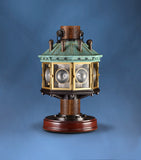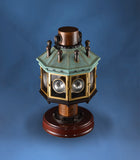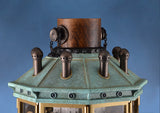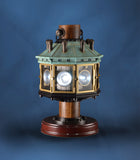50 PIECE LIMITED EDITION. THIS SCULPTURE WILL BE SOLD OUT RAPIDLY.
To customers who have purchased edition numbers #1-#50 of my previous releases, I wish to thank you for your support and would like to offer to you the same serial number of this piece that you have been accustomed to. This offer, however, only extends to purchases made by October 14th. At that time shipping of the first wave will commence and serial numbers will be assigned sequentially as to when completed orders were received and I can no longer guarantee you will get the same number.
To those whose previous serial numbers were #51 or higher, thank you also for your past support but I regret that I will not be able to honor those numbers, as there will only be 50 of these lights produced and all numbers will be sequential from #1-#50."
The Lightship has a unique place in the history of maritime law. Anchored over treacherous reefs, or marking the dangerous approaches to channels and harbors, these sturdy little vessels withstood the worst Mother Nature could throw at them. When the need for a warning light was imperative, yet a lighthouse couldn't be built, these remarkable ships and their crews stood sentinel over the hazards below the waves.
The primary responsibility of a Lightship is to shine a light at night to warn mariners of impending danger. Keeping a beacon alight throughout the night in all weather conditions was no easy feat. The earliest lights were simple iron braziers burning coal. These iron baskets would be hoisted up into the rigging so that the light could be seen over a short distance. Needless to say, they weren't very effective. Rain, heavy seas, and brisk winds could easily douse the fires, rendering the lightship next to useless. With advances in technology came the oil lantern. These robust little lights would be encased in a frame with glass windows protecting the flame from the wind to some degree. The lights had to be constantly maintained, refilling the oil, trimming the wicks and cleaning the soot off the lantern's glass panels. Unfortunately, the light from these small lanterns was not very bright and could not been seen over any great distance.
Over the years, the designs of lanterns and the quality of fuel oil improved. In as early as 1855, a design for a new type of lightship lantern came to prominence. Although there were many variations on this design the basic elements of the lantern remained the same. A large eight sided lantern was built using an iron frame. Mounted onto this frame were eight large bronze framed glass doors. The roof was usually made of copper. The frame of this hefty lantern was built around the mast of the ship. Inside the lantern would be eight silvered spherical reflector lamps.
On the deck of the lightship, a cabin was constructed around the perimeter of the main mast. The roof of this cabin hinged open on two sides allowing the lantern to be raised on chains up and out of the structure. The cabin protected the lantern from the worst of the elements, while the crew refueled the lantern and cleaned the reflectors and glass. Once the lamps were lit and all was ready, the roof opened up and the entire lantern apparatus was hoisted up the mast on chains linked to a human powered capstan.

The lightship crew hoisting the lantern up the main mast.
Much to the relief of the lightship crews, the labor intensive and heavy oil lit lanterns were quickly replaced with the latest technological improvements of the day. Most significant of which was the installation of the electric light bulb which was considerably brighter and more reliable. The use of glass optics such as the Fresnel lens was also used to intensify and direct the light into more powerful beams that could be seen for many miles.
The Lightship Lantern Sculpture
This sculpture represents one of the many various designs of the eight sided mast mounted lanterns.
Creating this piece has been a long time obsession of mine. I proposed this sculpture to a manufacturer nearly ten years ago. After showing him the early drawings I'd done of the piece, the manufacturer declined to proceed with the project as it was going to be far too complicated to make, and he felt that he wouldn't be able to charge me enough to cover all the headaches this piece was going to give him. So, this planned sculpture went onto the back burner along with so many other ideas I've had over the years.
Last year I looked over those original drawings and decided that it not only could be made, but should be made. I started the long process of sculpting and modeling this piece. I painstakingly molded each component making many modifications and numerous improvements throughout the process. At long last, with much patience, determination, and just a little cursing, the final sculpture as you see it today, came to life.
The original manufacturer may well be much wiser than I. It is a very complicated piece to make. It comprises over 70 separate components, which are in turn made from glass, wood, polymer fortified plaster and brass .
Each part has to be painstakingly fettled and shaped so that it precisely marries up with all the other components. Each segment of the sculpture is then carefully hand painted. To say that this sculpture has long since become a labor of love over a commercial endeavor, is a major understatement.
I'm also pleased to say that all but the LED lights, transformer, and the base felt were made here in the USA. Let's say 100% American made of 95% American made materials.
Each sculpture is completely hand made by me in my little San Diego studio. Due to the complexity of the manufacturing and how staggeringly long it takes me to make each piece, I'm limiting the edition of this sculpture to only 50 pieces.





